I was curious as to how much wood a person would need in order to survive a cold night stuck out in the woods without a dedicated shelter, sleeping bag, or other equipment. In other words, what would I need to do, and how much would I need to prepare when faced with an unplanned bivouac?
The scenario I envisioned was that I had become lost in the woods and needed to stay the night in order to avoid stumbling around in the dark and risking injury. I simulated that I had one hour to gather wood for a fire before darkness set in.
For this experiment, I was well rested, had eaten a good breakfast, and was sufficiently hydrated. I had not spent the entire day outdoors exerting myself by hiking and eating only trail food.
The air temp according to my Brunton Nomad was 24*F. The sun was out (although I was mostly shaded by the forest) and there was a light wind. There was about 4" of hard packed snow on the ground with 1" of powder on top. I wanted the temps to be a little colder, but this was the best chance I had at this exercise before a storm came through later in the week.
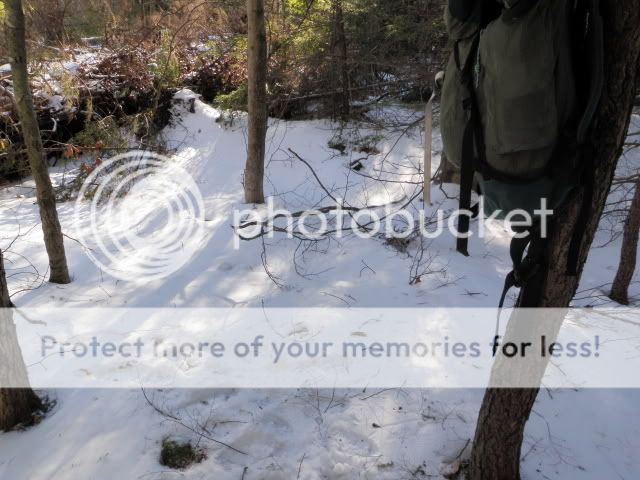
I selected an area of the forest which had an abundance of wood lying around. Part of this area had been cleared during the summer, so there were plenty of fallen trees to break branches from.
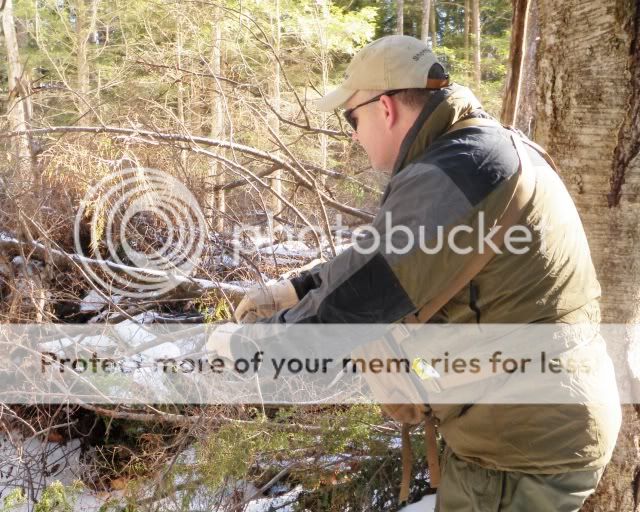
I began by collecting a bit of tinder and some finger size sticks from the branches of downed trees. I also looked around the general area for dead limbs and small dead trees. I had my wood-prep tools with me, but confined myself to only using wood which I could break with my hands or stomp into smaller pieces with my feet. There wouldn’t be any sawing or splitting wood on this trip.

After an hour of gathering, I had a stack of wood piled up that was about 3’ high and 4’ across. I had only traveled about 15 yards around the area I had selected for my fire to collect the wood. I didn’t spend any other time in wood prep other than to break the wood into pieces about 18” in length. I planned to further prep the wood as I fed it into the fire. This would be the only wood I used in the test.
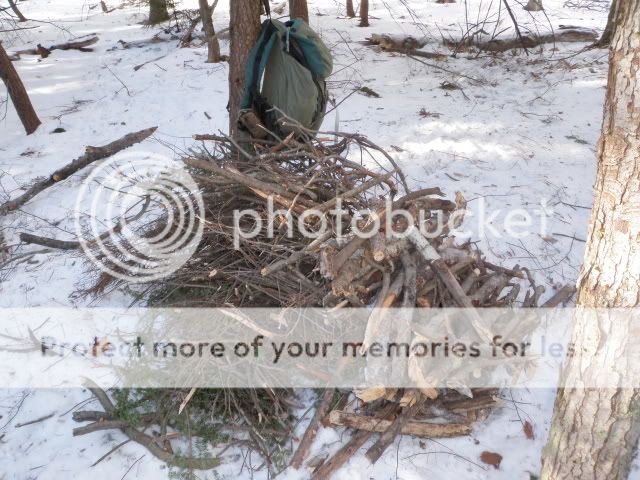
As part of the test, I wanted to further assess the effectiveness of expedient fire reflectors.
I used a USGI casualty blanket with some bungee cords for the first fire-reflector.
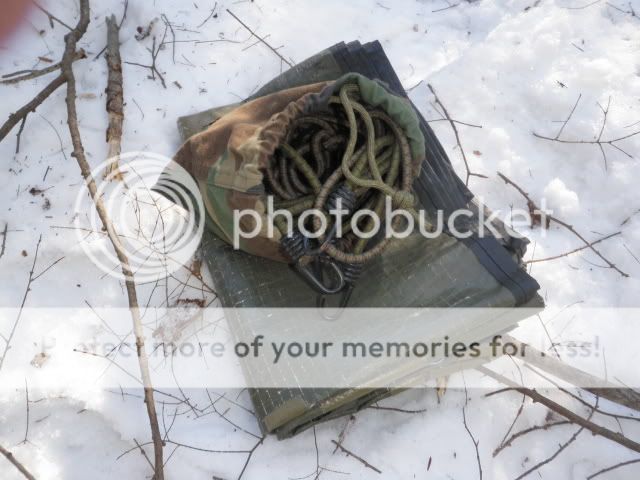
The corners of the casualty blanket have grommets in them and I simply hooked the bungee cord into the top corners and then routed the bungee cord around the tree and hooked the bungees to each other.
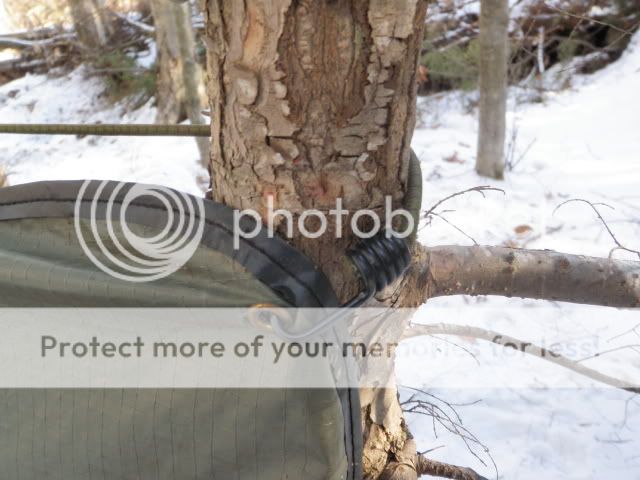
The bottom of the casualty blanket was secured by merely laying a log on top of it. This proved to be sufficient as the winds were light throughout the day. This fire-reflector was assembled in about four minutes.
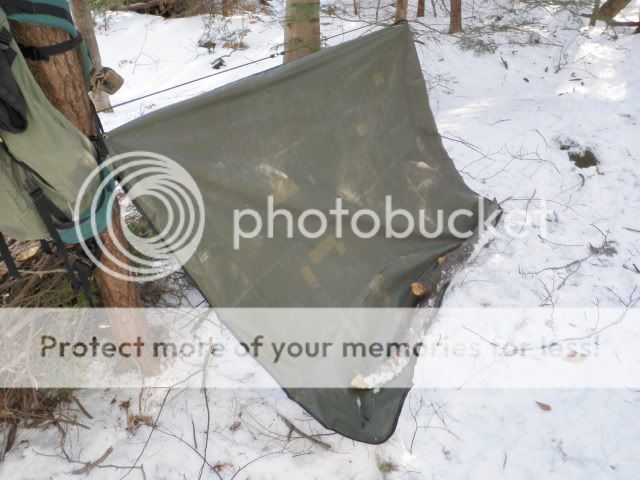
The second reflector consisted of a generic Mylar “space blanket” and several lengths of 550 cord.
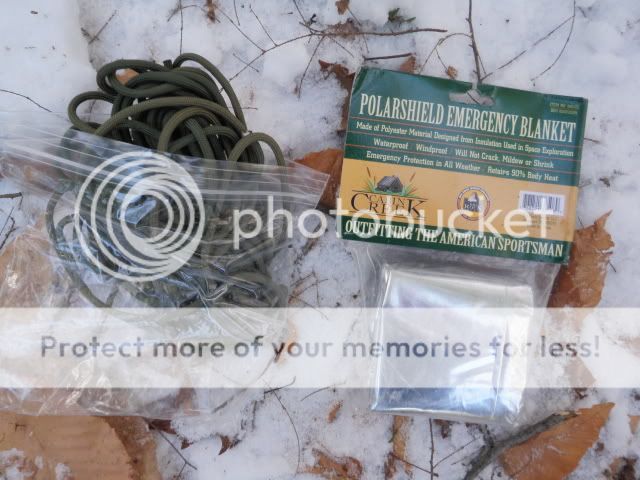
To erect the reflector, I tied an overhand knot in each corner of the space blanket to keep the cordage from slipping off.
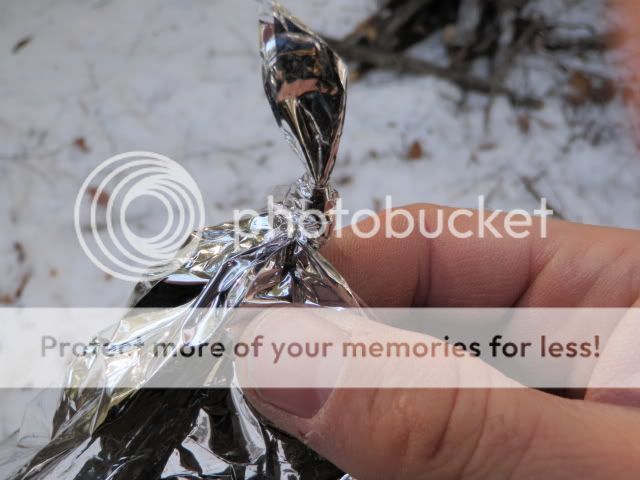
Then I tied a round-turn and two-half hitches just above the overhand knot.
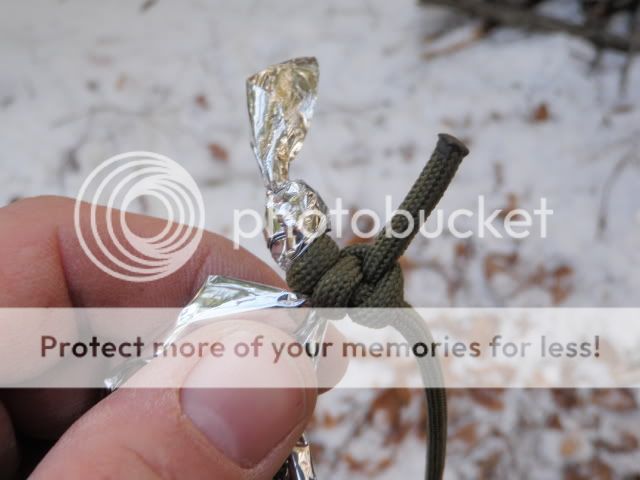
Each top corner of the space blanket was tied off to a tree using a taught-line hitch. This hitch is simple to tie and quick to adjust.
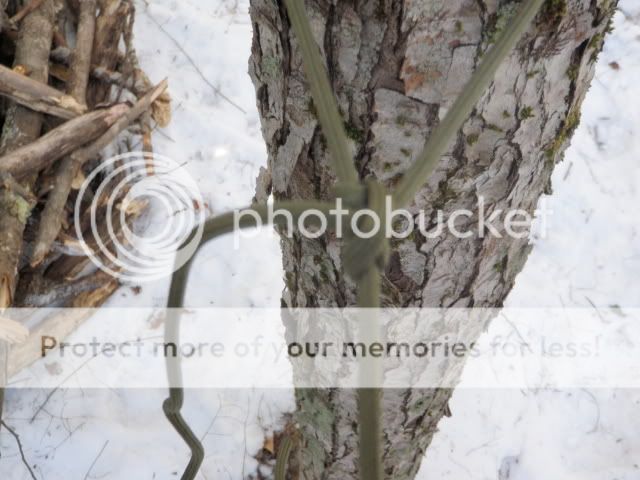
The bottom corners were secured by simply by wrapping the line around a log and adjusting the tension. Again, this proved sufficient.
This fire-reflector took a little over ten minutes to assemble. Compared with the casualty blanket (which unfolds easily) the space blanket had to be deliberately unfolded. This was not as easy as spreading a sheet over a bed. I took additional care not to rip or tear the space blanket. This is what took up the majority of the time, and additional time was spent tying all the knots.
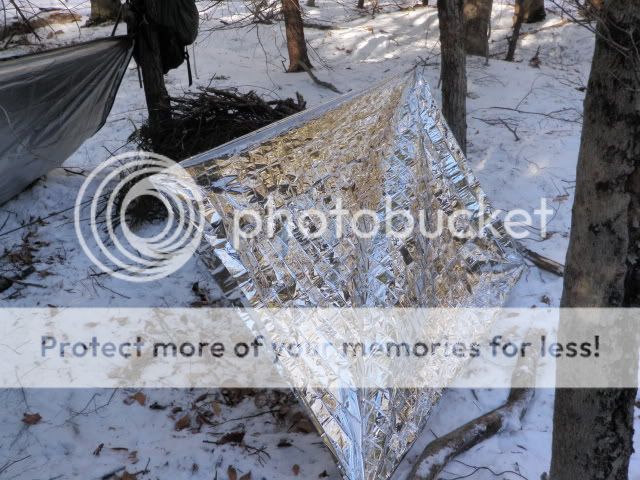
Prior to starting the fire, I took a temperature reading using my Cen-Tech Non-Contact Pocket Thermometer. I wanted a baseline temperature reading in which to compare later after the fire was going.
The casualty blanket read 28*F on the outside (green) and 30*F on the inside (reflective).
The space blanket would not give me a consistent reading. After several attempts the readout on the thermometer would display temperatures +/- 50*F.
I lit the fire (blast match, cotton balls / Vaseline) and sat down on my trusty square of USGI closed cell foam mat.
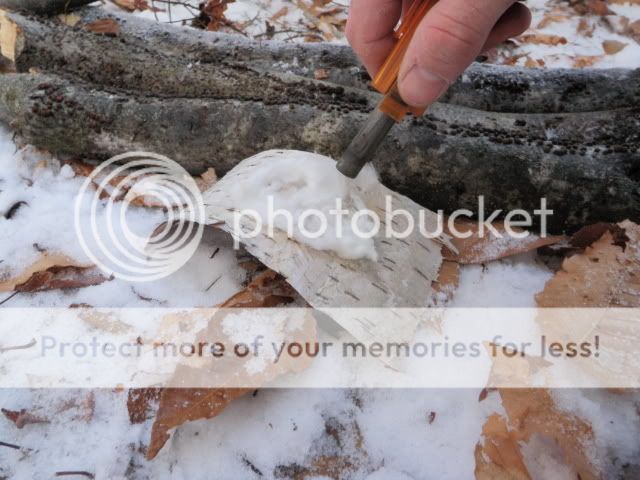
Thirty minutes into the test –
The fire was well established. I used the pocket thermometer to take a few more reading. Behind me, in the area of the casualty blanket that was “shadowed” by my body, the temperature was 60*F. To the side, in the area with a direct line to the fire the temperature was 107*F. On the outside of the casualty blanket the temperature was 36*F behind my shadow and 40*F to the side of it.
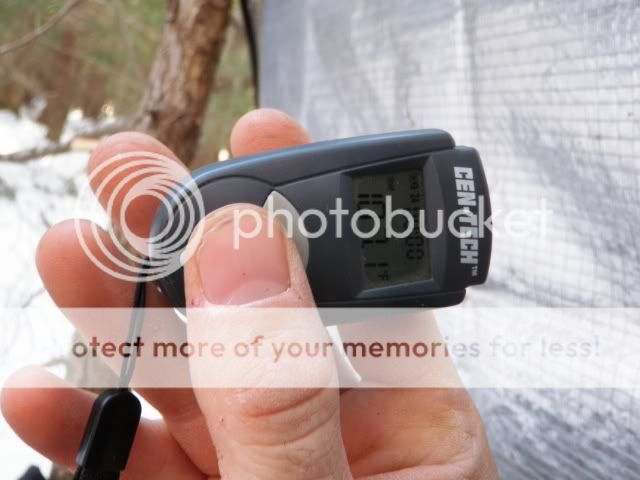
The space blanket continued to give sporadic readings; “Hi” <error>, 211*F, and 146*F on the inside. The outside temperatures were a little more consistent; 16*F, 22*F, and 25*F.
One hour into the test –
All the finger sized wood was consumed. I started to use the larger pieces of wood, breaking them smaller with my knee or by fire cutting them.
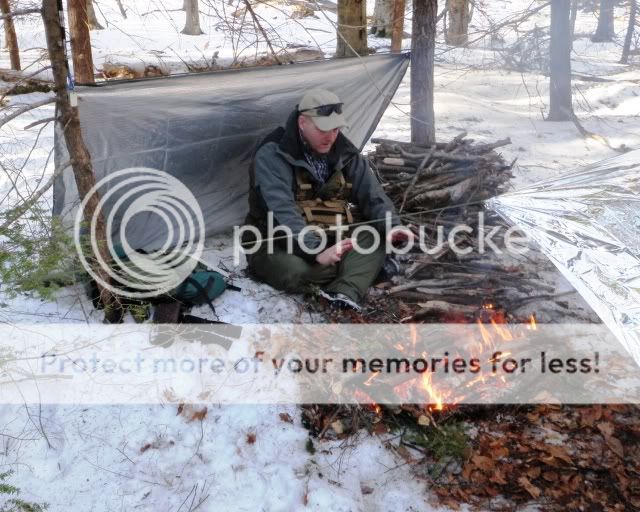
I had set the casualty blanket up so that the wind would be at my back, but as the day wore on, the wind swirled around from different directions and naturally kept the smoke in my face for most of the afternoon (or at least it seemed that way).
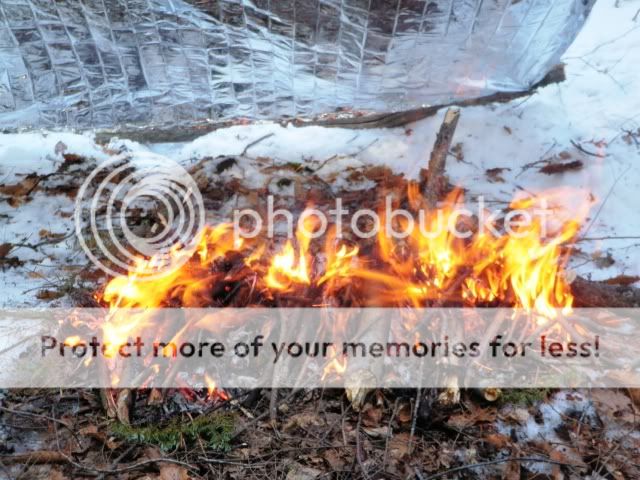
Two hours into the test –
I noticed that the area directly underneath the space blanket was devoid of snow. Thinking that I’d rather have that energy directed back at me, I got up to reposition the space blanket.
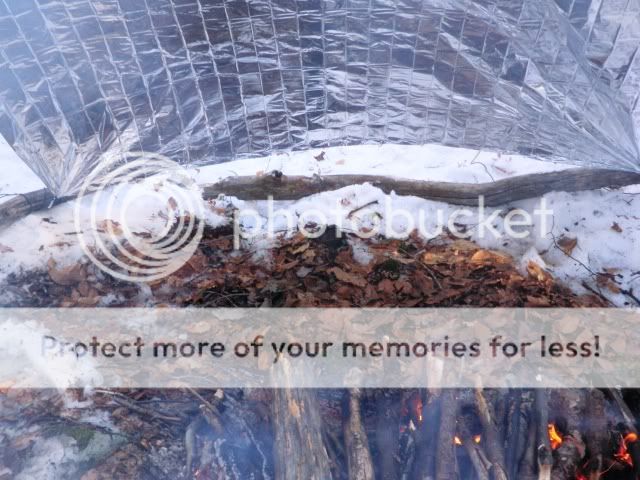
I adjusted it so that it was more vertically oriented.
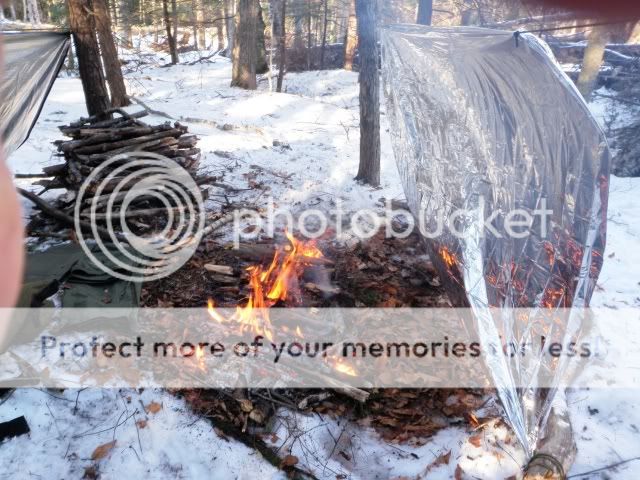
It was at this time that I noticed some holes in the space blanket. Some holes were the size of a pencil. I’m not sure if they resulted from embers coming up from the fire or from the space blanket getting too close to the flames.

The nature of the way I had the space blanket set up and the light wind caused the space blanket to “billow” back and forth from time to time. The way I managed the fire was also inconsistent. At times I would allow the fire would burn down to just coals. Then I’d add some wood, and then the wind would pick up, fanning the flames higher than I had anticipated. From this point on I made sure to keep a better watch on the flames and their proximity to the space blanket.
I used the pocket thermometer to take a few more reading. Behind me, in the shadow, the casualty blanket read: 71*F. To the side, the temperature was: 112*F. On the outside of the casualty blanket the temperature was 38*F behind my shadow and 40*F to the side of it.
“S.A.W.G.ing” an average of the readings for the space blanket resulted in 143*F on the inside and 40* on the outside.
Three hours into the test –
Once all the medium pieces of wood were gone, it was difficult to keep the fire small enough to protect the reflectors and at the same time large enough to sustain the largest pieces of wood. This would have been a good time to break out my Corona folding saw and my Fiskars hatchet so that I could prep the wood into smaller and more manageable sizes, but I limited myself to gathering what I could with only my hands / feet.
I had placed a small key-chain on the bungee cord next to my head; as you can see it reads; 57*F.
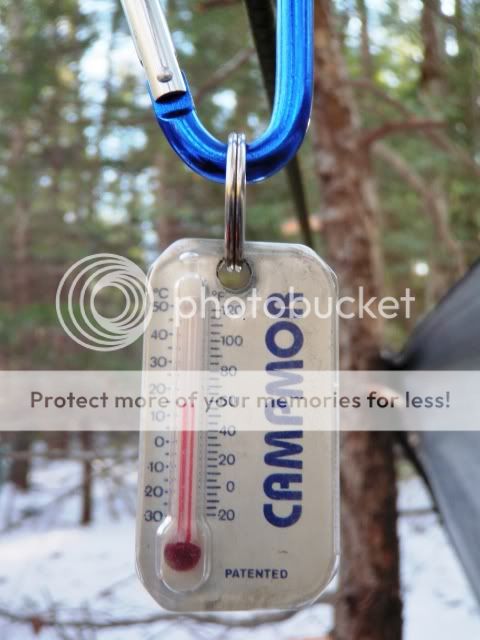
I used the pocket thermometer again to take a few more reading. Behind me – in the shadow, the casualty blanket read: 41*F. To the side, the temperature was: 104*F. On the outside of the casualty blanket the temperature was 37*F behind my shadow and 41*F to the side of it.
The space blanket continued to give sporadic readings; 165*F, 109*F, and 96*F on the inside. The outside temperatures were; 54*F, 39*F, and 33*F.
I was out of usable wood; this combined with the unexpected length of the test helped me decide that the test had run its course. I packed up and headed back inside.
Lesson learned –
The wood I had collected in one hour was sufficient to last me three hours without getting cold or even shivering. The fire reflectors certainly helped, as my back never got cold, but I was surprised that so little wood lasted as long as it did. I one point I was so warm that I took off my coat, CW pants, and boots.
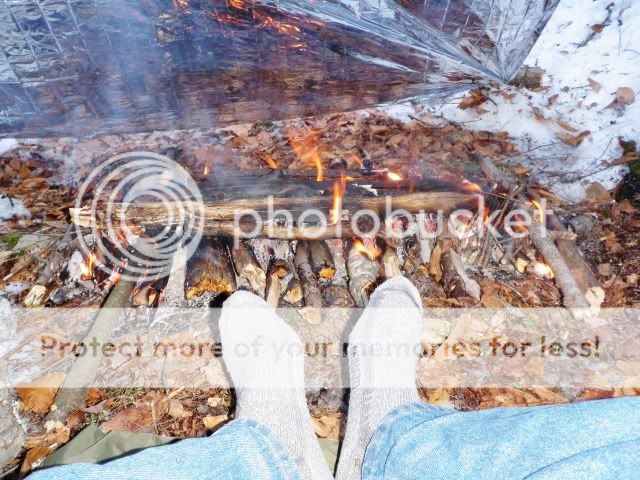
One hour prior to darkness is not sufficient time to decide that you are going to be spending the night “under the stars” and collect wood / build shelter. If the temperature had been any colder, then snow deeper, or the wind gusts higher, the results would have obviously been different – and not from a beneficial standpoint. The fact that I was neither mentally or physically fatigued, nor injured at the start was also a factor in the outcome of this experiment.
If I were to do this again (under the same conditions; i.e. – no wood tools) I would focus exclusively on only collecting wood I could snap across my knee and smaller. Wood larger than this (that I could only stomp on or smash over a rock to beak down) was still too big to keep the fire under control and sustained.
Collecting a sufficient amount of wood for this test was enabled by a shallow snow cover and abundance of blown down trees. There was plenty of other wood to be gathered around the area if I had allowed myself more time. Now that there is an additional foot of snow on the ground, finding enough wood would be dependent on the available time and using branches / standing dead-fall. In this part of the woods there are still plenty of tree tops from the 2008 ice storm lying around that this would not be a problem.
One other thing I wanted to do (but didn’t) was to clear away the coals and lie down on the heated ground and cover myself with the casualty blanket, just to see how well that worked and for how long.
Next time I’ll use the space blanket on the same side where I sit and the casualty blanket across from me. I’m curious to see if sitting with my back to the space blanket will make any difference.
I also suspect that two smaller fires located at 10:00 and 2:00 in front of me may be warmer than one big fire located at 12:00 to my front. My hunch is that more heat energy would pass by me and be reflected.
The scenario I envisioned was that I had become lost in the woods and needed to stay the night in order to avoid stumbling around in the dark and risking injury. I simulated that I had one hour to gather wood for a fire before darkness set in.
For this experiment, I was well rested, had eaten a good breakfast, and was sufficiently hydrated. I had not spent the entire day outdoors exerting myself by hiking and eating only trail food.
The air temp according to my Brunton Nomad was 24*F. The sun was out (although I was mostly shaded by the forest) and there was a light wind. There was about 4" of hard packed snow on the ground with 1" of powder on top. I wanted the temps to be a little colder, but this was the best chance I had at this exercise before a storm came through later in the week.

I selected an area of the forest which had an abundance of wood lying around. Part of this area had been cleared during the summer, so there were plenty of fallen trees to break branches from.

I began by collecting a bit of tinder and some finger size sticks from the branches of downed trees. I also looked around the general area for dead limbs and small dead trees. I had my wood-prep tools with me, but confined myself to only using wood which I could break with my hands or stomp into smaller pieces with my feet. There wouldn’t be any sawing or splitting wood on this trip.

After an hour of gathering, I had a stack of wood piled up that was about 3’ high and 4’ across. I had only traveled about 15 yards around the area I had selected for my fire to collect the wood. I didn’t spend any other time in wood prep other than to break the wood into pieces about 18” in length. I planned to further prep the wood as I fed it into the fire. This would be the only wood I used in the test.

As part of the test, I wanted to further assess the effectiveness of expedient fire reflectors.
I used a USGI casualty blanket with some bungee cords for the first fire-reflector.

The corners of the casualty blanket have grommets in them and I simply hooked the bungee cord into the top corners and then routed the bungee cord around the tree and hooked the bungees to each other.

The bottom of the casualty blanket was secured by merely laying a log on top of it. This proved to be sufficient as the winds were light throughout the day. This fire-reflector was assembled in about four minutes.

The second reflector consisted of a generic Mylar “space blanket” and several lengths of 550 cord.

To erect the reflector, I tied an overhand knot in each corner of the space blanket to keep the cordage from slipping off.

Then I tied a round-turn and two-half hitches just above the overhand knot.

Each top corner of the space blanket was tied off to a tree using a taught-line hitch. This hitch is simple to tie and quick to adjust.

The bottom corners were secured by simply by wrapping the line around a log and adjusting the tension. Again, this proved sufficient.
This fire-reflector took a little over ten minutes to assemble. Compared with the casualty blanket (which unfolds easily) the space blanket had to be deliberately unfolded. This was not as easy as spreading a sheet over a bed. I took additional care not to rip or tear the space blanket. This is what took up the majority of the time, and additional time was spent tying all the knots.

Prior to starting the fire, I took a temperature reading using my Cen-Tech Non-Contact Pocket Thermometer. I wanted a baseline temperature reading in which to compare later after the fire was going.
The casualty blanket read 28*F on the outside (green) and 30*F on the inside (reflective).
The space blanket would not give me a consistent reading. After several attempts the readout on the thermometer would display temperatures +/- 50*F.
I lit the fire (blast match, cotton balls / Vaseline) and sat down on my trusty square of USGI closed cell foam mat.

Thirty minutes into the test –
The fire was well established. I used the pocket thermometer to take a few more reading. Behind me, in the area of the casualty blanket that was “shadowed” by my body, the temperature was 60*F. To the side, in the area with a direct line to the fire the temperature was 107*F. On the outside of the casualty blanket the temperature was 36*F behind my shadow and 40*F to the side of it.

The space blanket continued to give sporadic readings; “Hi” <error>, 211*F, and 146*F on the inside. The outside temperatures were a little more consistent; 16*F, 22*F, and 25*F.
One hour into the test –
All the finger sized wood was consumed. I started to use the larger pieces of wood, breaking them smaller with my knee or by fire cutting them.

I had set the casualty blanket up so that the wind would be at my back, but as the day wore on, the wind swirled around from different directions and naturally kept the smoke in my face for most of the afternoon (or at least it seemed that way).

Two hours into the test –
I noticed that the area directly underneath the space blanket was devoid of snow. Thinking that I’d rather have that energy directed back at me, I got up to reposition the space blanket.

I adjusted it so that it was more vertically oriented.

It was at this time that I noticed some holes in the space blanket. Some holes were the size of a pencil. I’m not sure if they resulted from embers coming up from the fire or from the space blanket getting too close to the flames.

The nature of the way I had the space blanket set up and the light wind caused the space blanket to “billow” back and forth from time to time. The way I managed the fire was also inconsistent. At times I would allow the fire would burn down to just coals. Then I’d add some wood, and then the wind would pick up, fanning the flames higher than I had anticipated. From this point on I made sure to keep a better watch on the flames and their proximity to the space blanket.
I used the pocket thermometer to take a few more reading. Behind me, in the shadow, the casualty blanket read: 71*F. To the side, the temperature was: 112*F. On the outside of the casualty blanket the temperature was 38*F behind my shadow and 40*F to the side of it.
“S.A.W.G.ing” an average of the readings for the space blanket resulted in 143*F on the inside and 40* on the outside.
Three hours into the test –
Once all the medium pieces of wood were gone, it was difficult to keep the fire small enough to protect the reflectors and at the same time large enough to sustain the largest pieces of wood. This would have been a good time to break out my Corona folding saw and my Fiskars hatchet so that I could prep the wood into smaller and more manageable sizes, but I limited myself to gathering what I could with only my hands / feet.
I had placed a small key-chain on the bungee cord next to my head; as you can see it reads; 57*F.

I used the pocket thermometer again to take a few more reading. Behind me – in the shadow, the casualty blanket read: 41*F. To the side, the temperature was: 104*F. On the outside of the casualty blanket the temperature was 37*F behind my shadow and 41*F to the side of it.
The space blanket continued to give sporadic readings; 165*F, 109*F, and 96*F on the inside. The outside temperatures were; 54*F, 39*F, and 33*F.
I was out of usable wood; this combined with the unexpected length of the test helped me decide that the test had run its course. I packed up and headed back inside.
Lesson learned –
The wood I had collected in one hour was sufficient to last me three hours without getting cold or even shivering. The fire reflectors certainly helped, as my back never got cold, but I was surprised that so little wood lasted as long as it did. I one point I was so warm that I took off my coat, CW pants, and boots.

One hour prior to darkness is not sufficient time to decide that you are going to be spending the night “under the stars” and collect wood / build shelter. If the temperature had been any colder, then snow deeper, or the wind gusts higher, the results would have obviously been different – and not from a beneficial standpoint. The fact that I was neither mentally or physically fatigued, nor injured at the start was also a factor in the outcome of this experiment.
If I were to do this again (under the same conditions; i.e. – no wood tools) I would focus exclusively on only collecting wood I could snap across my knee and smaller. Wood larger than this (that I could only stomp on or smash over a rock to beak down) was still too big to keep the fire under control and sustained.
Collecting a sufficient amount of wood for this test was enabled by a shallow snow cover and abundance of blown down trees. There was plenty of other wood to be gathered around the area if I had allowed myself more time. Now that there is an additional foot of snow on the ground, finding enough wood would be dependent on the available time and using branches / standing dead-fall. In this part of the woods there are still plenty of tree tops from the 2008 ice storm lying around that this would not be a problem.
One other thing I wanted to do (but didn’t) was to clear away the coals and lie down on the heated ground and cover myself with the casualty blanket, just to see how well that worked and for how long.
Next time I’ll use the space blanket on the same side where I sit and the casualty blanket across from me. I’m curious to see if sitting with my back to the space blanket will make any difference.
I also suspect that two smaller fires located at 10:00 and 2:00 in front of me may be warmer than one big fire located at 12:00 to my front. My hunch is that more heat energy would pass by me and be reflected.

![Cheers [cheers] [cheers]](/xen/styles/default/xenforo/smilies.vb/018.gif)
![Thumbs Up [thumbsup] [thumbsup]](/xen/styles/default/xenforo/smilies.vb/044.gif)
![Wink [wink] [wink]](/xen/styles/default/xenforo/smilies.vb/002.gif)